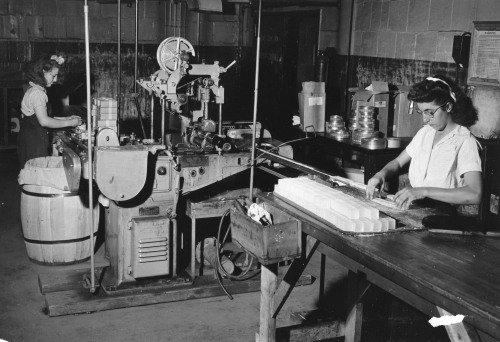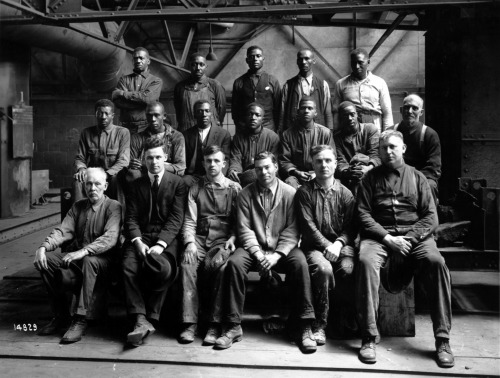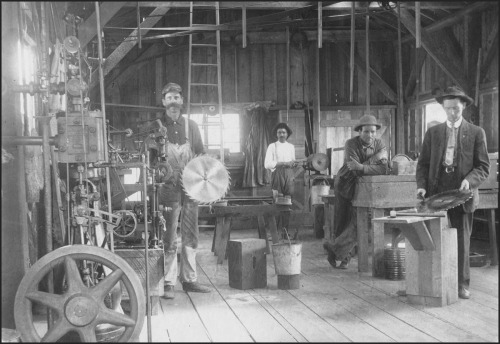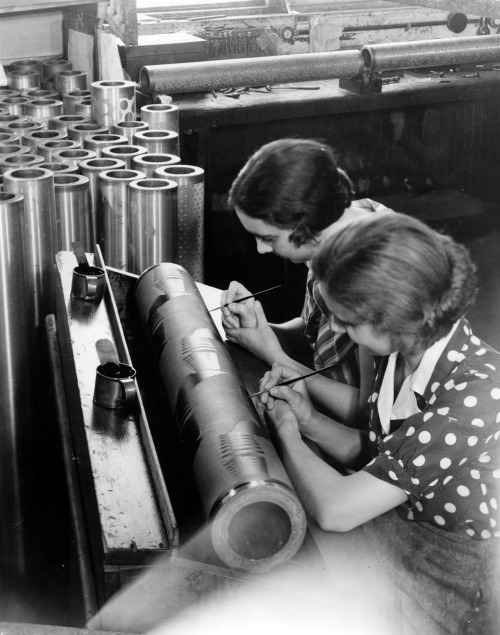#worker wednesday
This #WorkerWednesday, we’re making a visit to the Camphor Plant of E.I. du Pont de Nemours & Company’s Chambers Works facility.
The site, located on the Delaware River in Deepwater Point, New Jersey, was established by the DuPont Company in 1892 for the purpose of manufacturing gunpowder. Between then and when it closed in 2018, the site was used to develop, manufacture, and store a wide variety of chemical products, including Kevlar, nylon, Freon, leaded gasoline, and uranium processing for the Manhattan Project.
Camphor, an aromatic compound produced from the wood of camphor producing plants, or synthetically derived from turpentine, is a versatile product used in mothballs, embalming fluids, perfumes, medicinal products and, in the early years of the plastics industry, as a plasticizer used in the manufacturing of celluloid and plastic lacquers.
This ca. 1945 photograph is part of Hagley Library’s collection of DuPont Company Product Information photographs (Accession 1972.341). The DuPont Company created the Product Information section within the Public Relations department in 1952. Its function was to produce news releases with photographs about DuPont and its products for indirect publicity and advertising purposes.
This collection contains photographs of DuPont Company corporate events and proceedings, product trade shows and fairs, development and manufacturing processes, and the employees and facilities where the products were created. Most of the photographs were taken from the 1930s through the 1950s. This collection has not been digitized in its entirety, but you can view a selection of images online now. Just click here to visit its page in our Digital Archive.
Post link
This #WorkerWednesday, we’re paying a visit to the staff of the furnace and cupola in the Westinghouse Machine Company’s Melting Department foundry at the South Philadelphia Works in Essington and Lester, Pennsylvania.
The Westinghouse Machine Company, which became the Westinghouse Electric Corporation in 1945, manufactured gas and steam engines, turbines and mechanical stokers for use in railway systems, fire service pumping stations, the shipping industry, and other large scale industrial purposes. These foundry workers were photographed by company photographer Charles Yessel on May 12, 1920 for the company’s newsletter, Machine News.
This image is part of Hagley Library’s collection of Westinghouse Electric Corporation Steam Division photographs (Accession 1969.170). A curated selection of items from this collection has been digitized; our Digital Archive offers over 1,000 photographs from this resource dating from 1898 to 1964. These photographs cover a variety of subjects including building construction, turbine manufacturing, research facilities, machinery, executives and employees, and visitors to the facility. To view more material from this collection online now, click here.
Post link
Today’s #WorkerWednesday post brings us inside the tool room of the Hoopes Brothers & Darlington sawmill in Brooksville, Florida. A note on the reverse of this ca. 1907 photograph identifies the person on the far right as Frank Orville Reagan (1869-1937), the son of Owen Wily Reagan (1847-1909), the sawmill’s manager.
The company that owned the mill, Hoopes Brothers & Darlington, began in West Chester, Pennsylvania in 1867 as a manufacturer of wooden spokes for wheels. By the 1880s it had become one of the largest wooden wheel makers in the United States, with mills and timber harvesting operations established throughout the southern United States.
The mill seen here was established in 1906. Hoopes Brothers & Darlington had originally established their Florida operations in nearby Ocala in 1899, but relocated after exhausting local timber supplies and to take advantage of cheaper railroad freight rates. Owen Wiley Reagan had also managed the Ocala mill, with his son Frank working as assistant manager. After his father’s death in November 1909, Frank took over operations of the Brooksville mill.
This photograph is part of Hagley Library’s collection of Hoopes Brothers & Darlington, Inc. photographs (Accession 1969.099). This collection consists of miscellaneous images from the company, largely dating between 1900 and 1948, as well as advertising material and letterheads. To view the collection online now in our Digital Archive, click here.
Post link
Today’s #WorkerWednesday shows employees of the Joseph Bancroft & Sons Co. etching designs on textile rollers at the company’s Print Works Division in Eddystone, Pennsylvania.
This circa 1937 photograph is part of the Hagley Library’s collection of Joseph Bancroft and Sons Company photographs (Accession 1969.025). Joseph Bancroft, an Englishman trained in textile weaving in Lancashire, established his own cotton mill on the Brandywine near Wilmington, Delaware in 1831. The firm was incorporated as the Joseph Bancroft & Sons Company in 1889.
To view more material from this collection online now, click here to visit its page in our Digital Archive.
Post link




